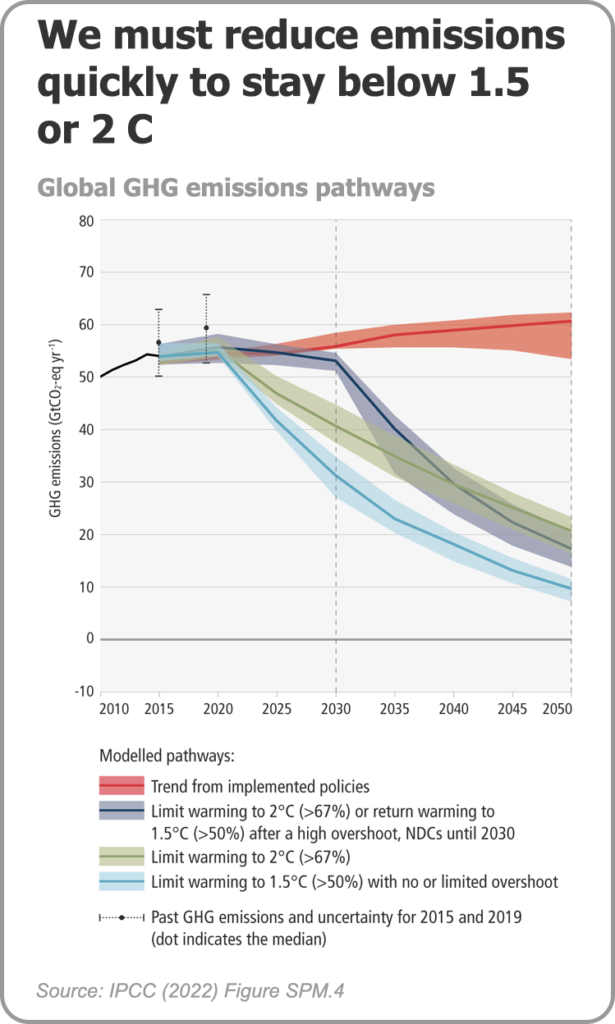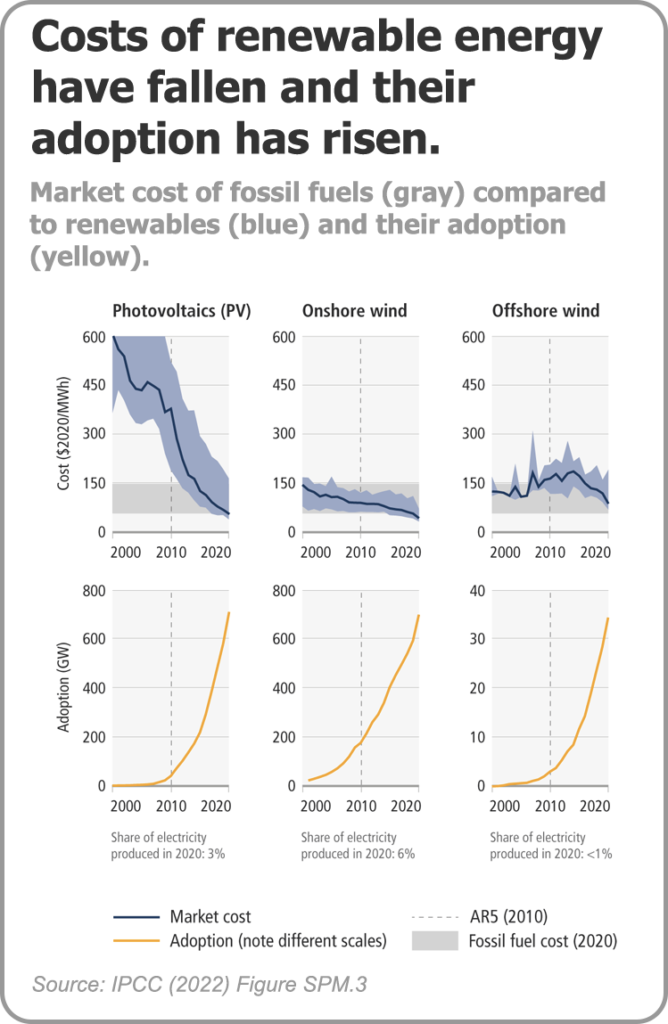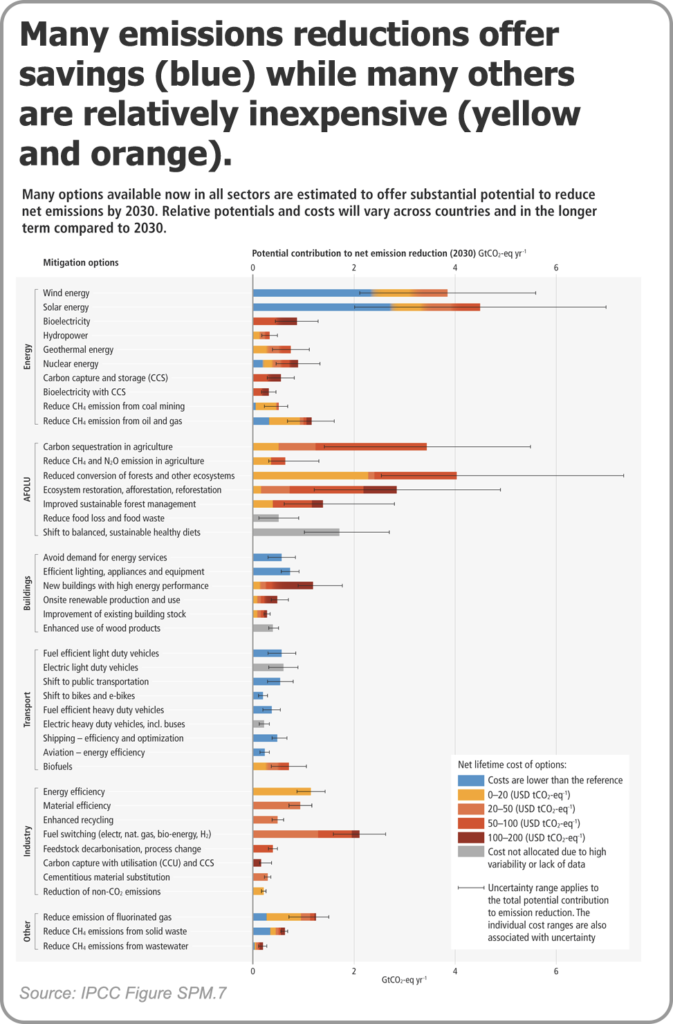Earlier this spring, the Intergovernmental Panel on Climate Change (IPCC) released the third report from its sixth cycle of assessments. The previous two reports in this cycle addressed the physical science and impacts and vulnerabilities, while this report from Working Group 3 addresses how to mitigate (slow down) the changing climate. The main things to take away from the latest IPCC report are:
- We still could, in theory, keep global warming below 1.5 degrees Celsius (2.7 degrees Fahrenheit), avoiding the most catastrophic impacts of a changing climate.
- But we would need to act swiftly, slashing emissions by nearly half by 2030. We would need to act immediately even to limit warming to 2 C (3.6 F), a temperature rise that would have worse impacts than 1.5 degrees of warming but still better than the path we are on.
- We must immediately decarbonize electricity (mostly by using more wind and solar) and electrify other sectors where possible.
- More generally, we should make maximum use of low-carbon solutions throughout the economy, including transportation, industrial processes, agriculture, and forests. Decarbonization is already cheaper than fossil fuels in many cases and often offers additional benefits beyond reduced greenhouse gas (GHG) emissions, such as cleaner air and water.
The report exhaustively examines everything we know about just how much we should cut emissions in each sector, what it will cost us if we succeed, and what it will cost us if we don’t. Here are some highlights (with citations to the relevant paragraphs of the summary for policymakers):
Without further policy action, we’re probably on a path to 3.2 C (5.8 F) warming.
In Figure 1, red shows likely GHG emissions slowly rising through 2050 with current policies in place. A slow rise is better than the rapid increases of recent decades. But still, that way lies about 3.2 C (5.76 F) of warming. (C.1.3) Not good. As the IPCC’s previous report on impacts and vulnerabilities said, “economic damages generally increase non-linearly with global warming levels.” Double the warming means much more than double the damage. Though better than nothing, our current policies still put us at high risk of wildfires, biodiversity loss, heat-related deaths, and more.
Figure 1

To stay on the path to 1.5 C, we need to act now. Otherwise, the best we can hope for is 2 C. Or more.
In Figure 1, above, light blue shows how quickly we need to reduce global emissions to stay below 1.5 C of warming. We would need to cut emissions nearly in half by 2030 and 80 percent by 2040. To stay below 2 C, we could follow the green line in the graph, cutting emissions by one-quarter or one-third by 2030 and in half by 2040. If each country complies with its current commitments, called nationally determined contributions (NDCs) (purple path, until it hits the dotted line at 2030), that is a better path than the red one we are currently on and would lead to slight reductions in global emissions by 2030 (B.6.1). At that point, we would likely have blown our chances of keeping warming below 1.5 C and would have to scramble mightily to try to get back on track (see the steep decline in the purple line past 2030, diving down past the green line.) (B.6.4)
Turning on a dime and starting to dramatically slash emissions from 2030 onward would be far more difficult than getting started on necessary transformations now. We need to use all tools at our disposal to decrease emissions wherever we can and as soon as we can. As the report reminds us, sticking to 1.5 C, and even to 2 C, will require “rapid and deep and in most cases immediate GHG emission reductions in all sectors.” (C.3)
If there is one takeaway from this whole dense report, it is this: We must reduce emissions significantly by 2030. If we don’t, we are locking ourselves into dangerous levels of warming.
We need to build more electric power, but almost all of it should be zero or low-carbon.
On all pathways to 1.5 C, coal power nearly disappears globally by 2050. (C.3.2) In the United States, we should build no new coal plants — which often operate for more than half a century — because they will become stranded assets. (C.4.4) The modeled paths show more demand for electricity as more transportation and industrial demand becomes electricity. Still, all of that power comes from renewables or fossil fuels paired with carbon capture and storage (CCS). (C.3.2)
Happily, wind and solar are already cheaper than coal and gas in many cases.
Bill Gates talks about the Green Premium, the additional amount you have to pay to get a low-carbon version of something. As it turns out, the Green Premium is already a Green Bonus in many cases for electricity, since solar and wind often cost less than coal or gas. In Figure 2, blue shows a range of prices for photovoltaic (PV), onshore wind, and offshore wind. Gray shows the range of prices for fossil fuel-fired electricity in 2020. (Figure SPM.3) Solar prices have dropped dramatically in the last 20 years, to the point where they are now in the same range as fossil fuels; no Green Premium needed. In response to falling costs, PV adoption has shot up (yellow line).
Figure 2

Electricity systems in some countries and regions are already predominantly powered by renewables. However, to phase out fossil fuels entirely and create a robust, reliable, carbon-free electricity system, we will need storage, smart grids, more transmission lines, demand-side management, etc. (C.4.3) But the transition to lower-carbon energy will also reduce local pollution, improving Americans’ health. (C.4.2) The United States has the opportunity to lead. We must relentlessly deploy these renewables, which will make them even cheaper. In addition to reducing climate pollution and air pollution, renewable energy offers many other benefits over fossil fuels: The more you use it, the cheaper it gets. The new technology is moving along a learning curve, finding lower-cost ways to manufacture, build, and manage. In contrast, fossil fuels are an input that gets more expensive when we use them more.
Agriculture, forestry, and other land use offer big opportunities at relatively low cost.
One of the biggest areas where the United States could lead the way toward global emissions reductions is managing rural lands. Specifically, implementing agricultural practices that sequester carbon, prevent forests from being destroyed, and revive forests and other lands that have been damaged or cut down. The Trillion Trees Act could be a step in the right direction.
Figure 3 shows the quantity of emissions that could be cut from various sectors and how much that might cost. The first two bars, for wind and solar, show both how huge their potential is globally — saving potentially around five or six gigatons of GHGs per year each. The blue part of the bars shows what portion of those GHG savings would be achieved at a cost savings compared to sticking with the status quo.
Figure 3

The next category down, agriculture, forestry, and land use (AFOLU), also shows a lot of potential for reducing emissions, especially by conserving and replanting forests and using agricultural practices to sequester carbon in the soil. Those bars are mostly yellow and orange, indicating that these strategies would cost around $20 or $50 per ton saved. However, these cost estimates only consider GHG emissions. The report points out that many of these practices offer other benefits, such as conservation, clean water, rural livelihoods, and reduced vulnerability to a changing climate. (C.9)
We need to invest in RD&D in the industrial sector.
As the graph above also shows, there are relatively low-cost opportunities to reduce industrial emissions through energy efficiency, material efficiency, and enhanced recycling. However, that is not enough to reduce emissions as much as we need. To stay on the pathway to 1.5 C, the industrial sector will need a more focused industrial policy. (C.5.1). Many low-carbon industrial processes are in the pilot phase or near-commercial phase, or even commercially available but not yet widely adopted. (C.5.2) The industrial sector can decarbonize by electrifying, using zero-carbon hydrogen, and carbon capture, but those options are not universally available and often not cost-effective. We need more research, development, and deployment (RD&D) to bring industrial decarbonization technologies from pilot to widespread deployment. (C.4.6)
Because this sector is exposed to international competition, the United States will need to act swiftly and coordinate with other countries to ensure that domestic industries don’t lose their current carbon advantage and instead stay at the forefront of low-carbon practices. (C.2.3 and C.5.4) We could spur change in the industrial sector without exposing the domestic industry to international disadvantage with a carbon tax plus a border adjustment.
The transportation sector offers cost savings and leadership opportunities.
The transportation sector accounts for a smaller share of global emissions than in the United States, where transportation emissions are on par with electricity. This sector requires less drastic cuts than the energy and industrial sectors: Reducing transportation emissions by about 60 percent is consistent with 1.5 C. With 30 percent reductions, we could still stay below 2 C. The blue bars in the figure above show that the opportunities to reduce emissions are already cost savers. They also have a lot of other benefits, such as cleaner air, reduced congestion, and reduced demand for materials. By aggressively pursuing electric and fuel-efficient vehicles and public transit and bikes, the United States could take a big bite out of our emissions, reap theco-benefits, and be a leader in low-carbon transportation. That would help other countries leapfrog past dirty and inefficient transportation options. (C.8.1, C.8.3, C.8.5)
We can get there for less than $100 per ton.
The color-coding of the bars in Figure 3 shows that the costs of carbon mitigation are surprisingly low in many cases. We could reach our global goal of halving emissions by 2030 at the cost of no more than $100 per ton. We could get halfway there with reductions that cost less than $20 per ton. (C.12.1)
This implies that a global carbon price of $100 per ton would put us on the path to 1.5 C. And the impact of such a policy on global economic growth would be minimal. Global GDP is expected to more than double by 2050 regardless of climate policy. The costs of reducing emissions to half their current level would reduce global GDP by just 1.3 to 2.7 percent of its much higher projected 2050 level. (C.12.2). Even a modest carbon price of $20 per ton could boost us along the path to 1.5 C, spurring market forces to find the lowest-hanging fruit (for example, developing more wind and solar, accelerating energy efficiency, conserving forests, and capturing methane emissions) and leaving lawmakers to choose more expensive regulatory approaches for the remainder.
The U.S. could do its part towards 1.5 C with legislation along the lines of the Save Our Future Act. But if the U.S. chooses to use regulatory approaches instead of a carbon price, the IPCC report gives a good benchmark for considering which regulations are cost effective. Decision makers should scrutinize options that cost more than $100 per ton because there is likely a less expensive way to get the same GHG reductions. Unless the policy provides other benefits, such as cleaner air, it is not the best option.
Accelerate decarbonization now.
Climate change is already creating costly damages in the form of wildfires, heat waves, floods, and droughts. Even with our progress in the past decade, we are still on path for things to get much, much worse. We need to act now to get on a path where things only get somewhat worse. The good news is that decarbonization is already competitive in the biggest sector (energy). We just have to deploy the clean technologies we already have. Although there will be a cost to transition in other sectors, there are immediate benefits of cleaner air and water, and the long-term benefits of decreased climate-related risk, disruption, and disasters.
Photo credit: iStock